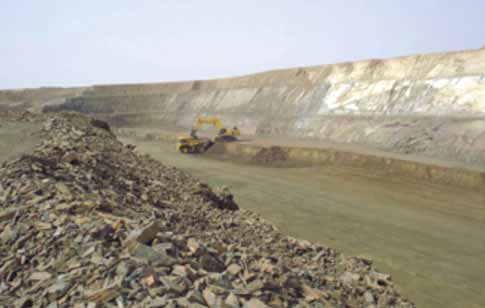
Anglo American’s recently announced $4-billion write-off for its
Minas-Rio iron ore project is seen by some observers as a move
to ‘clear the decks’ for incoming CEO Mark Cutifani, pictured here.
Anglo American, Barrick and Kinross Report Major Asset Impairments

Anglo American: Anglo American an-nounced on January 29 that following a review of capital expenditure require-ments for its Minas-Rio iron ore project in Brazil, it would record an impairment charge of $4 billion against the project on a post-tax basis as of December 31, 2012. Capital expenditure for Minas-Rio development is projected to increase to $8.8 billion, up from an earlier estimate of $5.8 billion. Anglo American acquired the project in two installments in 2007 and 2008 for $4.8 billion.
The announcement said that, despite the challenges the Minas-Rio project has faced, the company is targeting first ore shipments from the project by the end of 2014. The project is being developed to produce 26.5 million mt/y of iron ore pellet feed.
In mid-February, Anglo American announced a current probable ore reserve of 1.45 billion run-of-mine mt for the Serra do Sapo area of the Minas-Rio pro-ject, equivalent to 685 million mt of saleable product at an average grade of 67.5% iron. The probable ore reserve represents a partial conversion of materi-al previously classified as resources. The project’s resource total currently stands at 4.27 billion mt grading 32.22% iron.
Following one-off impairments, Anglo American reported a full-year 2012 loss attributable to equity shareholders of $1.5 billion.


Barrick:In its report of fourth-quarter and full-year 2012 financial results, released February 14, Barrick recorded a fourth-quarter after-tax asset impairment charge of $3 billion for its 100%-owned Lumwana open-pit copper mine in Zambia. The com-pany also recorded a goodwill impairment of $0.8 billion for its copper business unit for a total charge of $3.8 billion.
Barrick acquired Lumwana in 2011 when it acquired Equinox Minerals for approximately C$7.3 billion. Barrick’s 2013 production guidance for Lumwana is 210 million to 250 million lb of cop-per in concentrates at C1 cash costs of $2.70 to $3.10/lb and C3 fully allocated costs of $3.20 to $3.60/lb.
The Lumwana impairment results from revised life-of-mine cost estimates under current copper price assumptions, reduced expected copper production, and, in turn, reduced profitability over the mine life.
“We continue to progress a number of key initiatives to lower costs, including improvements to operating systems and processes, and a full transition to an owner-maintained operation. A focus on higher utilization and productivity of the mining fleet has also been identified as one of the major opportunities to improve value. Until we can improve mining costs, and/or copper prices increase, the expansion opportunity to increase the throughput capacity of the processing plant does not meet our investment crite-ria,” the Barrick statement said.
For full-year 2012, Barrick reported a net loss of $0.67 billion, including after-tax impairment charges of $4.4 billion.
Kinross:In its report of fourth-quarter and full-year 2012 financial results, released February 13, Kinross reported an after-tax, non-cash impairment charge of $3.09 billion for its Tasiast gold pro-ject in Mauritania. The charge included $2.13 billion related to goodwill and an after-tax charge of $964.5 million related to property, plant and equipment.
The impairment test for Tasiast was based on a 30,000-mt/d optimized mill model, compared with a 60,000-mt/d model used for the 2011 annual impairment test.
Kinross acquired its 100% interest in the Tasiast gold project on September 17, 2010, upon completing its acquisi-tion of Red Back Mining in a transaction valued at $7.1 billion.
Kinross expects to complete a pre-feasibility study for construction of a mid-sized CIL mill in the 30,000-mt/d range in the first quarter of 2013. The company has decided not to proceed with further study of a 60,000-mt/d mill option. Work to date on the pre-feasibili-ty suggests that while a smaller mill will result in lower annual production, it will reduce capital requirements and execu-tion risk, provide improved per-ounce margins and cash flow, and preserve future optionality and expandability.
Kinross CEO J. Paul Rollinson said, “While we recorded a non-cash impair-ment charge related to our Tasiast pro-ject, our pre-feasibility study work and recent exploration results continue to increase our confidence in Tasiast’s potential and confirm its importance as part of our long-term future.
Kinross reported a full-year 2012 net loss, including impairment charges, of $2.55 billion.